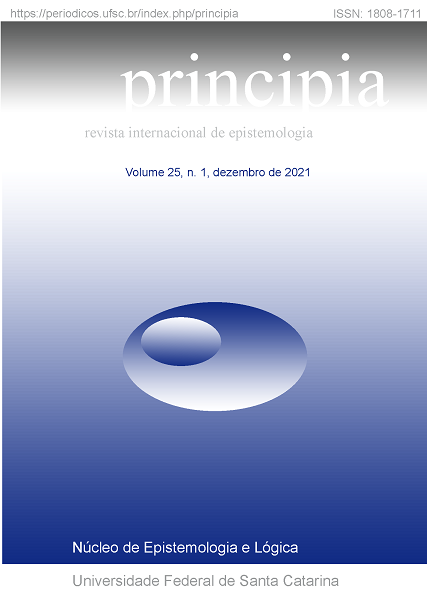La Actitud de La Obra de Arte
DOI:
https://doi.org/10.5007/1808-1711.2021.e71267Resumen
En este artículo elaboramos una propuesta sobre el significado de las obras de arte que se apoya en la perspectiva de Dennett acerca de la naturaleza de la intencionalidad de los fenómenos mentales. De acuerdo a ella, la intencionalidad que estos exhiben no es original, sino derivada. Adoptar la perspectiva de la intencionalidad derivada implica que ya no será posible sostener que el significado de una obra de arte esté vinculado al acto creativo que le dio origen o que esté determinado por las intenciones que tuvo su autor al crearlas, como han sostenido las teorías intencionalistas. Ahora bien, creemos que hay un aspecto de estas que no es incompatible con la perspectiva de intencionalidad derivada. Se trata del hecho de que parte del significado de la obra de arte está dado por las interpretaciones que surgen sólo cuando se asume que la misma fue producida por un agente con el propósito de transmitir algo. Llamaremos a esta estrategia interpretativa actitud de la obra de arte y defenderemos que debe ser entendida como un subtipo de la actitud intencional. Esta estrategia interpretativa forma parte de una propuesta que intenta explicar el significado de las obras de arte como siendo parcialmente indeterminado, relativo a una historia (y no a un origen fundacional) y dependiente de la atribución interpretativa.
Citas
Arnheim, R. 1962. Picasso's Guernica. Berkeley: University of California Press.
Beardsley, M. 1981. Aesthetics, problems in the philosophy of criticism. Indianapolis: Hackett Publishing.
Boden, M. 2004. The creative mind: Myths and mechanisms. United Kingdom: Routledge.
Brentano, F. 1995 [1874]. Psychology from an Empirical Standpoint. London: Routledge.
Briskman, L. 1980. Creative product and creative process in science and art. Inquiry 23 (1): 83-106.
Bullot, N. & Reber, R. 2013. The artful mind meets art history: Toward a psycho-historical framework for the science of art appreciation. Behavioral and brain sciences 36(2): 123-37.
Carroll, N. 1997. The intentional fallacy: Defending myself. The Journal of Aesthetics and Art Criticism 55(3): 305-9.
Carroll, N. 2000. Interpretation and intention: The debate between hypothetical and actual intentionalism". Metaphilosophy 31(2): 75-95.
Clark, A. 2002. That Special Something: Dennett on the Making of Minds and Selves. En: A. Brook and D. Ross (eds) Daniel Dennett, p.187- 205. Cambridge: Cambridge University Press.
Cope, D. 2004. Virtual music: computer synthesis of musical style. Cambridge: The MIT press.
Currie, G. 1995. Image and mind: Film, philosophy and cognitive science, Cambridge: Cambridge University Press.
Danto, A. 1964. The artworld. The journal of philosophy, 61(19): 571-84.
Danto, A. 1981. The Transfiguration of the Commonplace. Cambridge: Harvard University Press.
Davies, D. 2009. The Artistic Relevance of Creativity. En: Krausz, M., Dutton, D., & Bardsley, K. (eds.) The Idea of Creativity, p.213-34. Netherlands: Brill.
Dawkins, R. 1976. The selfish gene. Oxford: Oxford university press.
Dennett, D. 1998 [1987]. La actitud intencional. Trad. Zadunaisky. Barcelona: Gedisa.
Dennett, D. 1990. The interpretation of texts, people and other artifacts. Philosophy and phenomenological research, 50: 177-94.
Dennett, D. 1991. Real patterns. The journal of Philosophy, 88(1): 27-51.
Dennett, D. 1995. Darwin's dangerous idea. New York: Simon y Schuster, Inc.
Farrell, J. 2017. The Varieties of Authorial Intention: Literary Theory Beyond the Intentional Fallacy. Cham: Springer.
Gardner, H. 1970. Children's sensitivity to painting styles. Child Development 41(3): 813-21.
Goodman, N. 1976. Languages of Art: An Approach to a Theory of Symbols, 2nd edition. Indianapolis: Hackett Publishing Company.
Goodman, N. 1990 [1978]. Ways of Worldmaking. Madrid: La balsa de la medusa.
Gaut, B. 2010. A philosophy of cinematic art. Cambridge: Cambridge University Press.
Hirsch, E. 1967a. Validity in Interpretation. New Haven, CT: Yale University Press.
Hirsch, E. 1967b. In defense of the author. En: Iseminger, Gary (Eds.) (1992) Intention and interpretation, p.11-23. Philadelphia: Temple University Press.
Haugeland, J. 1998. Having thought. Cambridge: Harvard University Press.
Iseminger, G. (Eds.) 1992. Intention and interpretation, Philadelphia: Temple University Press.
Iseminger, G. 1996. Actual intentionalism vs. hypothetical intentionalism. The journal of aesthetics and art criticism, 54(4): 319-26.
Levinson, J. 1996. The pleasures of aesthetics: Philosophical essays. New York: Cornell University Press.
Linson, A. 2013. The expressive stance: Intentionality, expression, and machine art. International Journal of Machine Consciousness 5(2): 195-216.
Lyas, C. 1992. Wittgensteinian intentions. En: Iseminger, Gary (Eds.) (1992) Intention and interpretation, p.132-51. Philadelphia: Temple University Press.
Machotka, P. 1966. Aesthetic criteria in childhood: Justifications of preference. Child Development 37(4): 877-85.
Nünning, V., Nünning, A. & Neumann, B. (Eds.). (2010). Cultural ways of worldmaking: Media and narratives (Vol. 1). Walter de Gruyter.
Quine, W. 1969 [1960]. Word and object. Cambridge: Technology Press of Massachusetts Institute of Technology.
Searle, J. 1982. The myth of the computer. The New York Review of Books 29(7): 3-6.
Searle, J. 1992 [1983]. Intencionalidad: Un ensayo en filosofía de la mente. Madrid: Tecnos.
Spingarn, J. 1984 [1924]. Criticism in America. New York: Core Collection Micropublications.
Thomas, A. 2018. The Definition of Art. The Stanford Encyclopedia of Philosophy (Fall 2018 Edition), Edward N. Zalta (ed.), URL = <https://plato.stanford.edu/archives/fall2018/entries/art-definition/>.
Tolhurst, W. 1979. On what a text is and how it means. The British Journal of Aesthetics 19(1): 3-14.
Wimsatt, W. & Beardsley, M. 1946. The intentional fallacy. The Sewanee Review 54(3): 468-88.
Wreen, M. 2014. Beardsley's Aesthetics. The Stanford Encyclopedia of Philosophy (Winter 2014 Edition), Edward N. Zalta (ed.), URL: /https://plato.stanford.edu/archives/win2014/entries/beardsley-aesthetics/ (21/01/2020)
Antunes, J. 2017. Baronesa, Brasil. Película.
Loznitsa, S. 2016. Austerlitz, Alemania. Película.
Descargas
Publicado
Número
Sección
Licencia
Derechos de autor 2021 Malena León

Esta obra está bajo una licencia internacional Creative Commons Atribución-NoComercial-SinDerivadas 4.0.

Principia http://www.periodicos.ufsc.br/index.php/principia/index is licenced under a Creative Commons - Atribuição-Uso Não-Comercial-Não a obras derivadas 3.0 Unported.
Base available in www.periodicos.ufsc.br.



